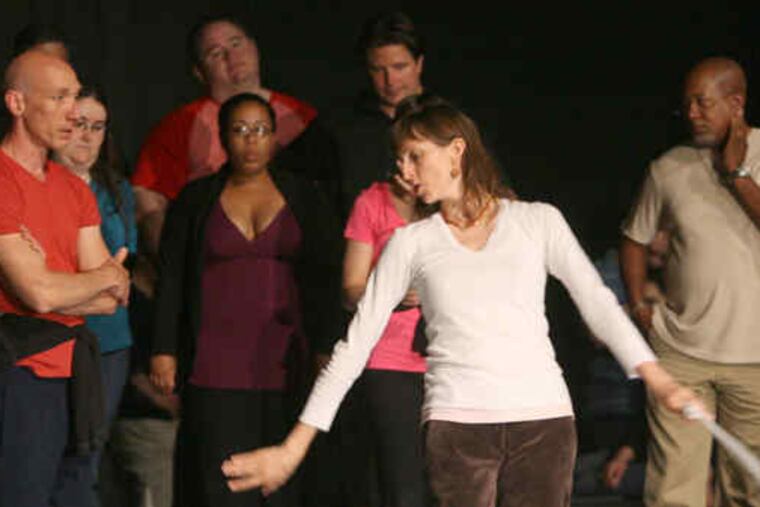Dancers adapt to two styles of music
In one rehearsal, they're dancing to baroque music; in the next, it's rock. They're either performing in a ground-breaking 18th-century opera production or making insta-dance. They're part of a large cast, or it's just the dancers.

In one rehearsal, they're dancing to baroque music; in the next, it's rock. They're either performing in a ground-breaking 18th-century opera production or making insta-dance. They're part of a large cast, or it's just the dancers.
Occasionally, similar moves or dance phrases wind up in both works.
Choreographer Amanda Miller is doing double duty this month. She's setting the dance for Gluck's Orphée et Eurydice - approximately 50 minutes of movement, almost half the opera's length - for the Opera Company of Philadelphia.
And her Miro Dance Theatre - the company she runs with husband Tobin Rothlein - is preparing a "best of" performance of their season of Miro Mash-Ups. Each Mash-Up gives dancers, a composer, and the Philadelphia-based rock band Toy Soldiers three days to create - and ultimately perform - a work.
On Saturday, Miller will all but own the Kimmel Center, when she has performances on both stages: Orphée (which opens Thursday) at the Perelman Theater and the Mash-Up in Verizon Hall, during the Kimmel Center's day-to-dawn Summer Solstice Celebration.
But she's not the only one who needs to keep it all straight. Her six dancers appear in both projects - four regulars, and two she found through opera auditions - and sometimes move from one to the other without a break.
"We did a Mash-Up rehearsal right before an Orphée rehearsal," Miller remembers, laughing. "And the Orphée choristers are coming in and looking at us - 'What are you doing?' "
Yet the projects are more similar than they sound.
"What is really interesting is that they're both about pairing the music and the dance, and finding connectivity and a narrative through line that allows them to make sense," Miller says.
And because Orphée is a modern retelling, Miller's contemporary choreography fits.
"I want to present this older piece in a new, kind of timeless manner," says Opera Company of Philadelphia artistic director Robert Driver. "I want to do it for today's audience in a modern, abstract way. The opera moves in a very smooth manner."
The work styles of the two projects were quite different, though.
"With the opera, the maestro is in the room for every rehearsal," Miller says. Corrado Rovaris will show her the score and explain if he, say, wants to soften a section.
"He wants all the elements to say the same thing at the same time," she says. Rovaris tells her, "This is how I hear it and this is how I'm going to conduct it, and can we match?"
A Mash-Up rehearsal moved her in the opposite direction when Toy Soldiers lead singer Ron Gallo took a rock song in 3/4 time and challenged her to choreograph it in 2/4. Oh, and suggested she maybe think Swan Lake.
"The brain is going in a thousand directions," Miller says, "marrying the music and the dance and the structures."
For Orphée, Driver wanted to wed even more pieces. He hoped to get out of the mold of the presentational dances, where the dance is separate from the rest of the action.
"I want to have the soloists, choristers, and the dancers all intermingle, so they are all persons in this story," Driver says.
"And I knew having worked with Amanda that she would get it immediately," he says of Miller, a former Pennsylvania Ballet dancer who worked with Driver on two other OCP operas, including last month's La Traviata.
This means Miller is choreographing not just her dancers, but the singers as well.
"I got to really integrate the chorus with the dancers and with the principals," Miller says. "We're trying to blur the lines."
Driver agrees. "It's impossible to separate it all out, and that's what we want," he says. It's exactly what I was hoping to achieve with this piece.
"I think we have something pretty special, the intertwining of the direction and the choreography."